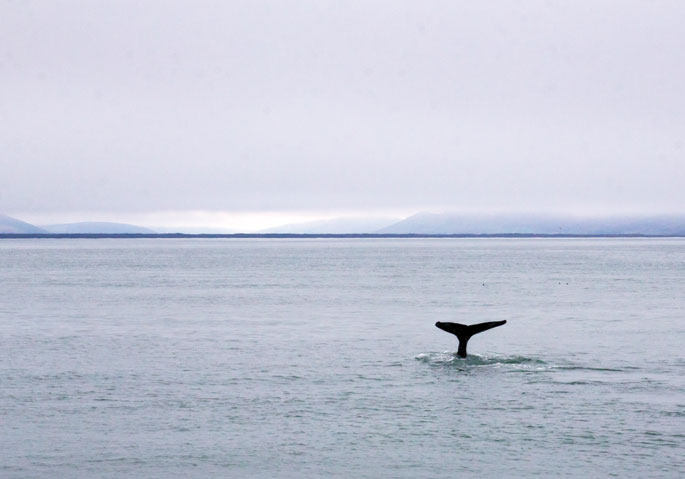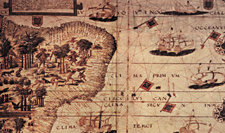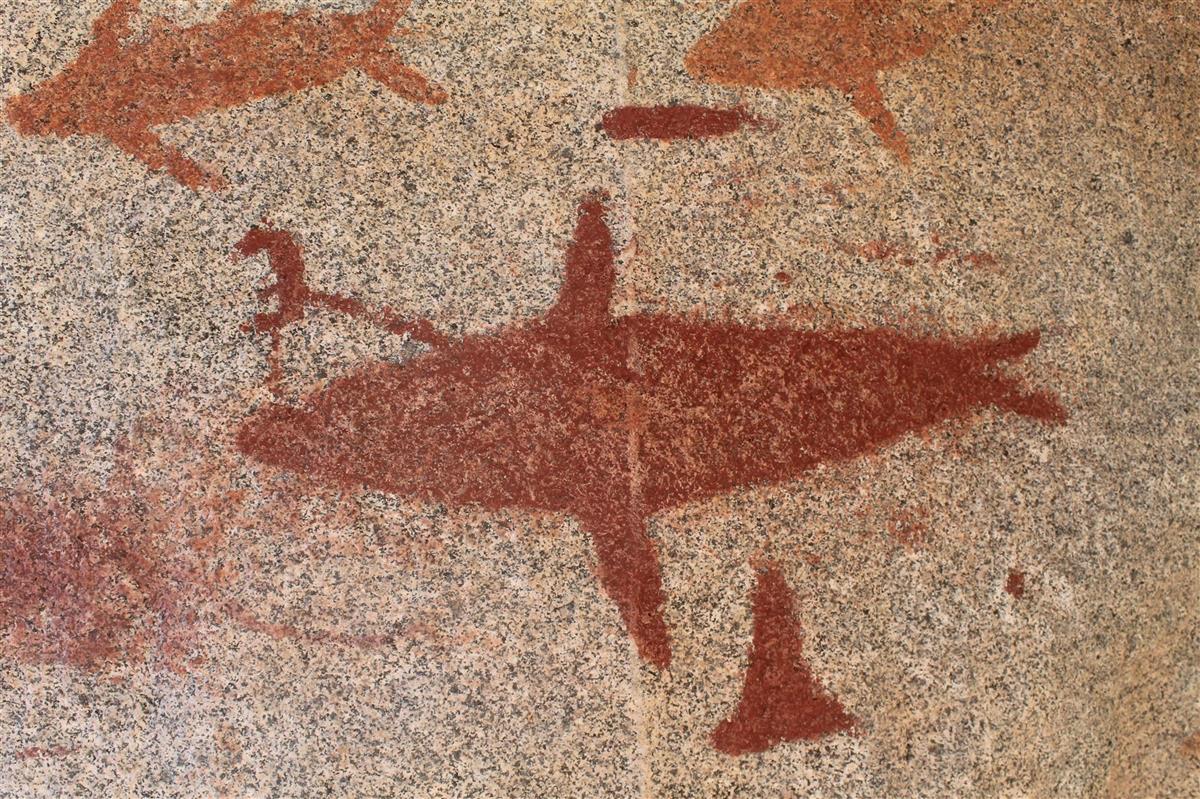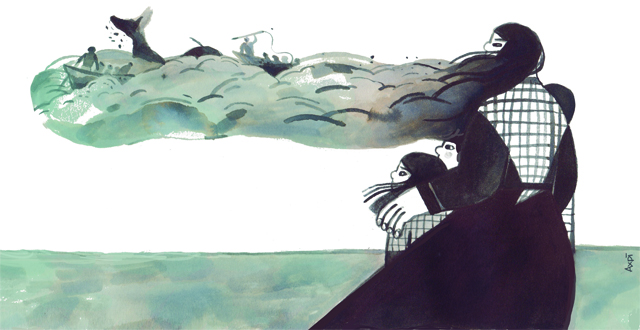In the wake of Basque whalers
- In 1615, the Basques who went to Iceland to hunt whales were massacred on the orders of a local head. Four centuries later, ARGIA has made a journey through these territories. In addition to knowing firsthand the important presence of the Basque whalers on this island, we have realized that the footprints left by those facts have not yet been shed.

In the Museum of the Western Fjords there is no trace of the history of Basque whaling. This exhibition site of the maritime heritage of the town of Ísafjörður is situated in the historic area of Neðstikaupstaður. Two young people welcome the visitor in the 18th-century building and the Basque whalers who were killed in 1615 nearby are not known either. But after a while they looked at each other and wondered: “Spánverjavígin? ”
The girls looked at the host man with some shame. June 2014. From what you've understood, it comes from a place called Euskal Herria, and it's precisely the place where they died from a fight that took place over 400 years ago. The Basque whale is an event that the Icelanders study at school and is known as the “murder of the Spaniards”. Apparently, this episode of the past causes a kind of national shame in a country historically characterized by a low rate of homicide and crime.
In the summer of 1615, three Basque boats arrived in Iceland to hunt whales. So they didn't know what their cruel fate would be. However, this episode is only one of the documented relations of the Basques with Iceland. The connection of the Basques with Iceland materialized mainly in the Western Fjords (Vestfirðir). The vestiges left by the Basque whalers are located north of the Snæfellsjökull glacier volcano, beyond the entrance chosen by Jules Vern to enter the heart of the Earth.
According to the autobiographical poem “Fjölmóður” published in 1625 by Jón Guðmundsson Jakintsua, in 1613 they arrived to the region called Strandir the first Basque boats prepared for whaling. After them many whaling boats from the Basque Country came to Strandi. But in 1615, the King of Denmark, who was under his kingdom, passed laws against the Basques hunting the whale in Iceland, in order to leave them out of his business. From the commercial relationship between Basques and Icelanders, the king did not make much profit, and that, of course, he did not like it. According to those laws, any Icelandic person was allowed to harass them if the Basques impacted the daily lives of its inhabitants.
The murder of the Basques
Shortly after the approval of the law by the Danish king, three Guipuzkoan boats ruled by Pedro Agirre, Esteban Telleria and Martín Villafranca arrived in the area in early summer. In fact, the year 1615 was a hard year in Iceland. The ice on the coast did not melt until summer and in the Western Fjords hunger continued to rise. Thanks to the agreement between the Basque whales and the Icelanders, the Basque whales had the opportunity to hunt about 10 whales.
Although at first the relations with the neighbors were good, it seems that the environment became a bit worse, due to the attitude of some of the sides. On 20 September, on the point of departure, there was a sudden storm and the ice pushed the boats into the rocks. Three men drowned. Another 82 sailors boarded boats and scrambled for larger boats. For the time being, they saved their lives.
When they landed, the Basques claimed minor debts from their inhabitants. In exchange for whale fat that they had been given a few weeks earlier, they wanted to get some sheepmeat for hungry neighbors. The priest Jón Grímsson rejected the request of the Basques and was beaten by the men of Martín de Villafranca. At that moment, it became forever a rarecid atmosphere.
When they arrived at Ísafjarðardjúp, the Basques decided to divide themselves into three groups. 50 sailors from Pedro de Agirre and Esteban de Telleria spent the winter near the Vatneyri. In the spring they threw themselves on an English fishing vessel, became their own and managed to escape from Iceland. We don't know if they came to Euskal Herria.
Under the command of Martín de Villafranca, divided into two groups, they had another destination. The fourteen men who embarked with his boat looking at the fjord of Dōrafjörður came to the town of Bliss. Along the way, they stole a number of things to survive in an abandoned Danish fishing zone. In their flight they collided with their inhabitants and killed all the sailors. The remaining 18 sailors, with Martin de Villafranca at the head, stayed on the island called Æðey, with the intention of spending the winter there.
Following the incident with the cure, Ögur leader Ari Magnusson convened an assembly to take action against the Basque whalers and gathered half a hundred people to attack the Basques. On the night of 13 October several Villafranca crew members were killed on the island of Æðey. The fugitives were intercepted in Sandeyri, near the small island, taking refuge in a hut.
Helpless, one of Magnusson's men injured the Donostian captain with an axe. He threw himself into the sea and tried to swim, mocking the Icelanders and singing. He swam like a “sea dog or a trick.” In fact, few would know how to swim at that time in Iceland, because in those cold seas it was impossible. Martín de Villafranca did not stop until he was beaten in the head with a stone, as Martín de Villafranca himself reported. They grabbed him, took him to the ground, and cut his neck off his navel with a knife. The rest of the Basque seamen, also in the quartet, filled the casings with stones and threw them into the sea, one by one, of one of those very typical Icelandic white abisms. Jon the Sage, questioning the official version, wrote that the Icelanders had had a relentless attitude towards the Basques.

Deposits
The Strandir region means “Costa” in Icelandic and has since been one of the most remote areas of the north-west coast of Iceland. Currently, about 800 people live in the area. On the fjord Steingrímsfjörður is a farm called Hveravík. The Strákatangi isthmus, at its feet, has kept a hidden treasure for centuries. There is the most important archaeological site left by the Basque whalers, at the height of Hólmavik, on the other side of the fjord.
Ragnar Edvardsson, an archaeologist at the University of Iceland, is probably the person who has studied the trail left by the Basques in Iceland. He has studied especially the whale season of Strákatangi through archaeological excavations. According to the researcher, although it was originally built and used by the Basques, it can be reused for years by Dutch and English hunters.
Last summer, Edvardsson offered two tours guided by the deposits. In addition to the Strákatangi, it has also found traces of whaling stations on the islands of Kóngsey and Strakéy, not far from there. According to the archaeologist, “given the size of the station, it is a mystery why it is not mentioned in any document of the time. Silence is absolute. And that’s very rare considering that the Basques’ performance was an industrial operation.” Therefore, it is not surprising that there are other undocumented deposits in the surroundings.
Whaling route
In Pingeyri three children play in the port. In June the days are endless and the children take advantage of all hours of light to be on the street. They try to catch the starfish, with half the body on the pier and the other hanging over the water. The small town is on its way from Reykjavik to Ísafjörður, about 200 kilometres from the capital. Many Basques were very close to there, 400 years ago.
The Strandir region has had a close relationship with witchcraft since time immemorial, whose inhabitants often suffered persecution from the church. Jon Guðmundsson himself wrote several books on spells and beliefs, and was sentenced to exile for witchcraft. He reminded Einar G., historian at the University of Iceland. Pétursson received in April 2015 at the Congress of the National Library of Iceland to commemorate the 4th Centenary of events. A symbolic act of reconciliation was also carried out in order to repeal in the twenty-first century the law adopted against the Basques. The event took place at the Museum of Witchcraft and Icelandic Enchantment of Hólmavik, with the presence of the heirs of the protagonists on both sides of the massacre.
In Iceland whaling is still authorised. Fortunately, today more people are hunted with cameras than those hunted with harpons. Every day, several boats leave the port of Husavík, east of the Basque hunting grounds. Tourists today use the same hunting boats as in the 1970s for tourists to see the whale. Some of these exits are led by a man named Robert.
As recalled at the Whale Museum in this town, “the Basques were the first Europeans to set up organized whaling in Icelandic waters. In the Western Fjords.” Robert knows the story of the Basque whalers, but tries to prevent the murder of the Basques. Once again, this national or similar shame is breathed upon the boat. Once the visit is over, call Captain Hörður to tell him that he was a Basque during the visit. Hörður is from San Sebastian and he has also, of course, heard about Martín de Villafranca. Leaning his head slightly as a gesture of respect, he wished to pay tribute to the fame of the Basque sailors: “Brave sailor, then.”
The last stop on the Basque whaling route is in Reykjavi, the capital of the country. At the Árni Magnusson Institute of the Haphly Islands University they have kept three jewels. They are Basque and Icelandic dictionaries written in the early 18th century, unparalleled witnesses of the relationship between the Basques and the Icelands. In one of these dictionaries, in the corner of the page, is written the name of the mammal that the Basques has immersed us in this journey, in Basque and Icelandic, as an eternal tribute: “Available: Hvalur”.
Euskal baleazaleek Islandian jasandakoak eleberri batetik ateratako istorioa dirudi, zalantzarik gabe. Hain zuzen ere, gertakarien 400. urteurrenaren harira hainbat erreportaje, liburu eta dokumental abiatu dira, “Baskavígin” bezala berrizendatua izan den gertakariaz.
Tapio Koivukari idazleak 1615 Islandia: Gartziaren istorioa izeneko liburuan gertakarien bertsio nobelatua eskaini du finlandieraz, eta Nafarroako Ikastolen Elkarteak ingelesera eta euskarara ekarri du lana. Bertan, Gartzia Aranburu kupelgilearen ikuspegitik aurkezten dira gertakariak, fikzioa nahasiz.
Julia Montejo idazle iruindarrak, bere aldetik, gaztelaniaz idatzi du baleazaleen istorioa ardatz duen Lo que tengo que contarte (Kontatu behar dizudana) eleberria. Euskaraz ere argitaratu da 1615. urtean gertatutakoaren inguruko kontakizunik, Iñaki Petxarroman kazetariaren eskutik. Kearen Fiordoa du izenburu.
Bestalde, aurten gutxienez bi dokumental osatzeko proiektuak abiatu dira Euskal Herrian. Eñaut Tolosaren zuzendaritzapean, Gogoan ekoiztetxeak lantaldea bidali zuen Islandiara pasa den udazkenean. Elkarrizketak eta grabazioak ez ezik, baleontzien arrastoak topatzeko urpekaritza saioak ere egin zituzten crowdfunding bidez finantzatutako Balezaleak egitasmoan.
Getxoko Old Port Films ekoiztetxea ere ari da dokumentala osatzeko aurre-ekoizpen lanetan. Aior Aspe da lanaren zuzendaria eta Baskavígin izango da filmaren izenburua.
Ez hartu harririk, ez teila zatirik, ez lorerik… ezer! Gure zapatilen arrastoa da zapalduko dugun lurrean utziko dugun bakarra. Ez egin harri pilarik, etorkizuneko arkeologoen lana baldintzatuko duzue eta. Horixe esan zigun Jason Edmundsek ondare kulturalaren zaintzaren... [+]
Bertaratutako euskaldunek Gran Bahia deitu zioten duela mende asko Ternua eta Labrador kasik bateratzen diren Belle Isleko itsasarteari. Arrantzaleek ustezko badia erraldoiaren sarrerako penintsula eta irla-artean ezarri zituzten baleak ehizatu eta euren olioa ateratzeko... [+]
Europako ontziak Ternua eta Labradorreko kostetara baleak eta bakailua arrantzatzera etortzen hasi zirenean, duela jada bost mende, ba omen zen Atlantiar kostetako badiatan nolabaiteko ohore kode bat. Galeoi edo ontziak leku bat hartu eta izendatzen bazuen, beste inork ezingo... [+]
Euskal balezaleen triskantza duela ia laurehun urte jazo zen hilketa ikertzea helburu duen dokumentala da. Txuri eta beltzik gabeko istorio bat, zuria esateko hamaika hitz dituen herrian.
Islandian oraindik geratzen da euskal baleazaleen aztarnarik, baita duela 400 urteko triskantzaren oroimenik ere. Bertako buruzagi baten aginduz hil zituzten hainbat arrantzale euskaldun, eta erreportaje honetan kontatu dizugu gertaturikoa. Argazkion bidez iraganean atzera egin... [+]






















